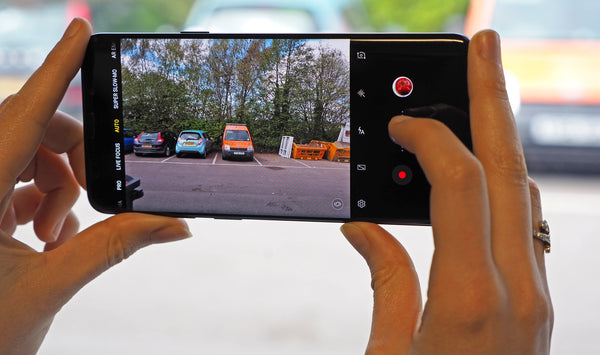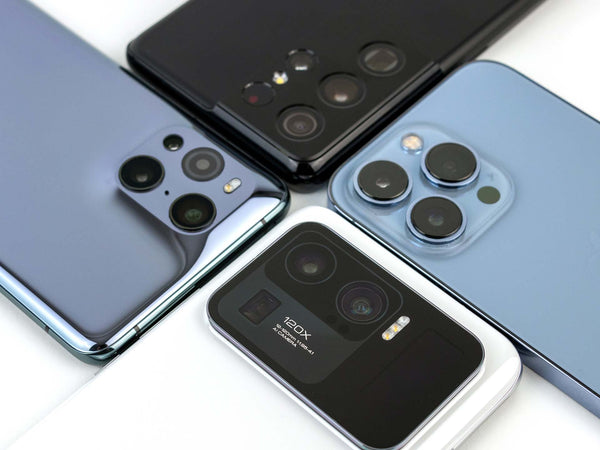Introduction
Smartphone cameras have become integral to our daily lives, revolutionizing how we capture and share moments. From spontaneous selfies to stunning landscapes, smartphone cameras have empowered us to become photographers on the go. These pocket-sized marvels have come a long way since their inception, evolving remarkably to deliver increasingly impressive image quality and functionality. In this blog post, we will explore the fascinating journey of smartphone cameras and how they have changed over time.
Over the years, smartphone cameras have evolved significantly, pushing the boundaries of what we can achieve regarding image quality, versatility, and creative expression. From the early days of low-resolution cameras to the introduction of high megapixels, optical image stabilization, and multi-camera systems, the evolution of smartphone cameras has been nothing short of remarkable. This blog post will take you through the various stages of this evolution, shedding light on the technological advancements that have shaped how we capture the world around us.

Early Days of Smartphone Cameras
In the early days of smartphone cameras & camera parts, capturing moments with a mobile device was a novel concept. These first-generation smartphone cameras were a far cry from the powerful imaging tools we have today. They needed to be more rudimentary, offering limited capabilities and producing low-resolution images. However, they laid the foundation for the technological advancements that were to come.
Introduction to the first-generation smartphone cameras
The introduction of the first-generation smartphone cameras marked a significant shift in how we interacted with our mobile devices. These cameras were a modest addition to the overall phone functionality, often offering basic features and relatively low megapixel counts. They served as an additional tool for capturing quick snapshots but were far from being considered primary imaging devices.
Limited capabilities and low-resolution images
Early smartphone cameras had their limitations. They struggled in low-light conditions, resulting in grainy and noisy images. The absence of advanced image processing algorithms and optical image stabilization meant that capturing crisp and clear shots took a lot of work. Additionally, these cameras had fixed focal lengths, restricting the ability to zoom or capture wide-angle shots.
The shift from basic point-and-shoot to integrated smartphone cameras
Despite their limitations, first-generation smartphone cameras paved the way for a transformative shift in the industry. As technology advanced, smartphones started integrating more advanced camera features and capabilities. Manufacturers recognized the potential of smartphone cameras and began investing in research and development to enhance their imaging capabilities.
Megapixel Race and Image Quality
The megapixel race has been a defining aspect of the evolution of smartphone cameras. Manufacturers have constantly pushed the boundaries by increasing the megapixel count, promising higher image resolution and sharper details. However, the impact of megapixels on image quality goes beyond mere numbers. Let's explore the relationship between megapixels and image quality in smartphone cameras.
Impact of increasing megapixels on image resolution
As smartphone cameras evolved, there was a notable increase in megapixel count. More megapixels meant higher image resolution, allowing larger prints and more flexibility in cropping images without significant loss of detail. Users could capture intricate details and enjoy sharper images on their smartphone screens.
Balancing megapixels with image quality and low-light performance
While higher megapixels offer advantages in terms of image resolution, it is crucial to strike a balance between megapixels and image quality. As the pixel size decreases with higher megapixels, the low-light performance and overall image quality can be impacted. Smaller pixels capture less light, resulting in noisier images in challenging lighting conditions.
Manufacturers have addressed this challenge by incorporating advanced technologies such as larger sensors, pixel binning, and improved noise reduction algorithms. These advancements aim to enhance low-light performance and mitigate the potential drawbacks of higher megapixels, ensuring a balance between resolution and image quality.

Advancements in image processing algorithms for better colors and detail
Image processing algorithms play a vital role in smartphone cameras, transforming the raw data captured by the sensor into a final image. With technological advancements, manufacturers have developed sophisticated algorithms that optimize colors, contrast, and dynamic range. These algorithms enhance the overall image quality by delivering more accurate colors, better detail retention, and improved dynamic range.
Furthermore, manufacturers have introduced features like HDR (High Dynamic Range) and computational photography, combining multiple exposures or utilizing AI algorithms to produce stunning images with balanced exposure and enhanced details in shadows and highlights.
Improvements in Optical Image Stabilization (OIS)
Optical Image Stabilization (OIS) has significantly advanced smartphone camera technology, revolutionizing how we capture sharp and steady images and videos. Let's delve into the concept of OIS and explore its benefits in improving image quality and overall smartphone photography experience.
Explanation of OIS technology and its benefits
OIS is a technology designed to counteract the natural hand movements that can cause image blur and shake while capturing photos or recording videos. It involves using mechanical components, such as gyroscopes and tiny motors, within the camera module to compensate for unintended movements. By continuously monitoring motion and rapidly adjusting the camera's position, OIS helps keep the image stable, resulting in sharper and clearer photos and videos. It effectively reduces the effects of hand tremors, allowing users to capture blur-free shots even in challenging shooting conditions.
Reduction of image blur and shake during photography and video recording
One of the primary benefits of OIS is its ability to reduce image blur and shake. Whether caused by slight hand movements, environmental vibrations, or camera shake during movement, OIS compensates for these motions in real time. This feature is particularly valuable when shooting in low-light environments or when using telephoto lenses, where even the slightest shake can significantly impact image quality. By stabilizing the camera module, OIS enables users to capture sharper, well-defined images and smoother videos, eliminating the frustration of blurry or shaky footage. It allows for more flexibility in handheld photography, reducing the reliance on tripods or other stabilizing equipment.
AI and Computational Photography
Integrating Artificial Intelligence (AI) in smartphone cameras has transformed how we capture and process images, taking smartphone photography to new heights. AI has played a pivotal role in enhancing various aspects of samsung camera, from image processing to scene recognition and auto-adjustments. Let's explore the impact of AI on smartphone photography and its role in popular features like portrait mode, night mode, and HDR.

Integration of Artificial Intelligence (AI) in smartphone cameras
AI technology has made significant strides in recent years, and its integration into smartphone cameras has unlocked a new realm of possibilities. By leveraging the power of machine learning algorithms and deep neural networks, AI algorithms can analyze and understand visual data to enhance the overall image quality and user experience.
Role of AI in enhancing image processing, scene recognition, and auto-adjustments
AI has revolutionized image processing by enabling smartphones to optimize various aspects of the captured image. AI algorithms can automatically adjust exposure, contrast, color balance, and noise reduction, resulting in more balanced and visually appealing photos. By analyzing the scene and subject, AI can identify and enhance specific elements, such as enhancing details in textures or improving the accuracy of skin tones. Furthermore, AI plays a crucial role in scene recognition, allowing smartphones to identify different types of scenes or objects in real time. This recognition capability enables the camera to automatically apply optimized settings and adjustments for specific scenarios, such as landscape, food, or night modes.
Impact on features like portrait mode, night mode, and HDR
AI has been instrumental in developing popular camera features like portrait mode, night mode, and HDR. Portrait mode uses AI algorithms to accurately identify the subject and apply depth-of-field effects, creating a pleasing background blur and enhancing the subject's sharpness. This feature has allowed smartphone users to capture professional-looking portraits with ease. Night mode, powered by AI, significantly improves low-light photography by capturing multiple exposures and intelligently combining them to reduce noise and enhance details. AI algorithms analyze the scene, adjust the exposure, and apply noise reduction techniques, resulting in stunning low-light images with improved brightness and clarity. HDR (High Dynamic Range) is another feature greatly enhanced by AI. AI algorithms analyze multiple exposures to capture a wide range of tones, preserving details in highlights and shadows. This results in well-balanced images with improved dynamic range, showcasing vibrant colors and capturing more intricate details in challenging lighting conditions.
In conclusion, AI has transformed smartphone cameras, enhancing image processing, scene recognition, and auto-adjustments. Through AI-powered features like portrait mode, night mode, and HDR, smartphones can capture stunning photos in various scenarios. The integration of AI has elevated smartphone photography, allowing users to capture professional-quality images and explore their creativity with ease effortlessly.
Advancements in Video Recording Capabilities
Smartphone cameras have come a long way in terms of video recording capabilities. Initially, basic video recording allowed users to capture low-resolution videos with limited quality. However, as technology progressed, smartphones introduced higher video resolutions, with 4K becoming a standard feature in modern devices.
The shift to 4K and beyond has dramatically improved video quality, offering sharper details, vibrant colors, and increased clarity. With the ability to record videos in ultra-high-definition resolutions, smartphone users can now capture videos that rival professional-grade cameras, enabling them to document their experiences with remarkable precision and fidelity.
Introduction of features like slow-motion, time-lapse, and cinematic video stabilization
In addition to higher resolutions, smartphones have introduced a range of features that enhance the creative possibilities and storytelling capabilities of video recording. Slow motion, time-lapse, and cinematic video stabilization are some notable features that have transformed how we capture and share videos.
Slow-motion allows users to record videos at a significantly lower frame rate, resulting in captivating slow-motion footage that highlights details and adds a dramatic effect. It enables users to capture stunning moments that would have otherwise gone unnoticed, bringing a new dimension to storytelling.
On the other hand, time-lapse compresses long periods of time into a short video, creating visually captivating sequences. This feature is particularly popular for capturing beautiful sunsets, busy cityscapes, or the blooming of flowers, offering a unique perspective on the passage of time.
Cinematic video stabilization has become a powerful tool for creating smooth, professional-looking videos. Leveraging advanced algorithms and motion sensors, smartphones can now stabilize footage, reducing the effects of camera shake and delivering steady and visually appealing videos. If you want to repair your precious camera repair near me, just visit our website www.mpdmobileparts.com and get the product.
Future Trends and Innovations
As smartphone parts of a camera continue to evolve, exciting new trends and innovations are shaping the future of mobile photography. From emerging technologies to the integration of augmented reality (AR) and virtual reality (VR), let's explore some predictions for the future of smartphone cameras and their impact on our photography experience.

Predictions for the future of smartphone cameras
The future holds immense potential for further advancements in smartphone camera technology. Here are some predictions for what we can expect:
- Increasing resolutions: We can anticipate even higher resolutions, surpassing 4K, as smartphone cameras push the boundaries of image quality.
- Enhanced low-light performance: Manufacturers will improve low-light capabilities, allowing for clearer and more detailed photos even in challenging lighting conditions.
- Advancements in zoom technology: Expect further improvements in zoom capabilities, integrating periscope lenses or other innovative optical systems to achieve even greater optical zoom ranges.
Impact of Augmented reality (AR) and virtual reality (VR) on smartphone camera capabilities
AR and VR technologies are set to revolutionize smartphone camera capabilities in the future:
- AR integration: Augmented reality will play a significant role in enhancing smartphone photography experiences. Users can overlay virtual elements onto the real world, such as interactive filters, virtual objects, or real-time information, creating engaging and immersive photography opportunities.
- VR content creation: As VR becomes more mainstream, smartphones will play a vital role in capturing and sharing VR content. Integrating 360-degree cameras and software advancements will empower users to create immersive virtual reality experiences easily.
- Real-time AR effects: Expect more advanced real-time AR effects, where users can apply filters, effects, and animations directly through the smartphone camera. This will enhance creative expression and offer unique ways to capture and share moments.
Conclusion
Throughout the years, smartphone cameras have undergone a rapid evolution. We started with first-generation cameras that offered limited capabilities and low-resolution images. However, with each new generation, smartphone cameras have pushed the boundaries, introducing higher resolutions, improved image quality, and innovative features. The megapixel race brought us sharper and more detailed images, while advancements in optical image stabilization reduced blur and enhanced low-light performance. The introduction of dual and triple camera systems expanded the versatility and creative possibilities. At the same time, the integration of AI and computational photography revolutionized image processing and introduced features like portrait mode and night mode.
In conclusion, smartphone cameras have changed how we capture, share, and experience the world. From humble beginnings to the sophisticated cameras we have today, they have evolved into powerful tools for visual storytelling and self-expression. As we embrace the remarkable journey of smartphone cameras, let us celebrate their impact on photography, acknowledge their role in shaping visual culture, and eagerly anticipate the exciting advancements and possibilities. The future of smartphone cameras is full of endless potential, promising even more incredible moments and capturing the beauty of our world with unprecedented clarity and creativity. If you want to buy any essential phone parts and do not find a reliable store, please visit mpdmobileparts.com and get your phone parts.

